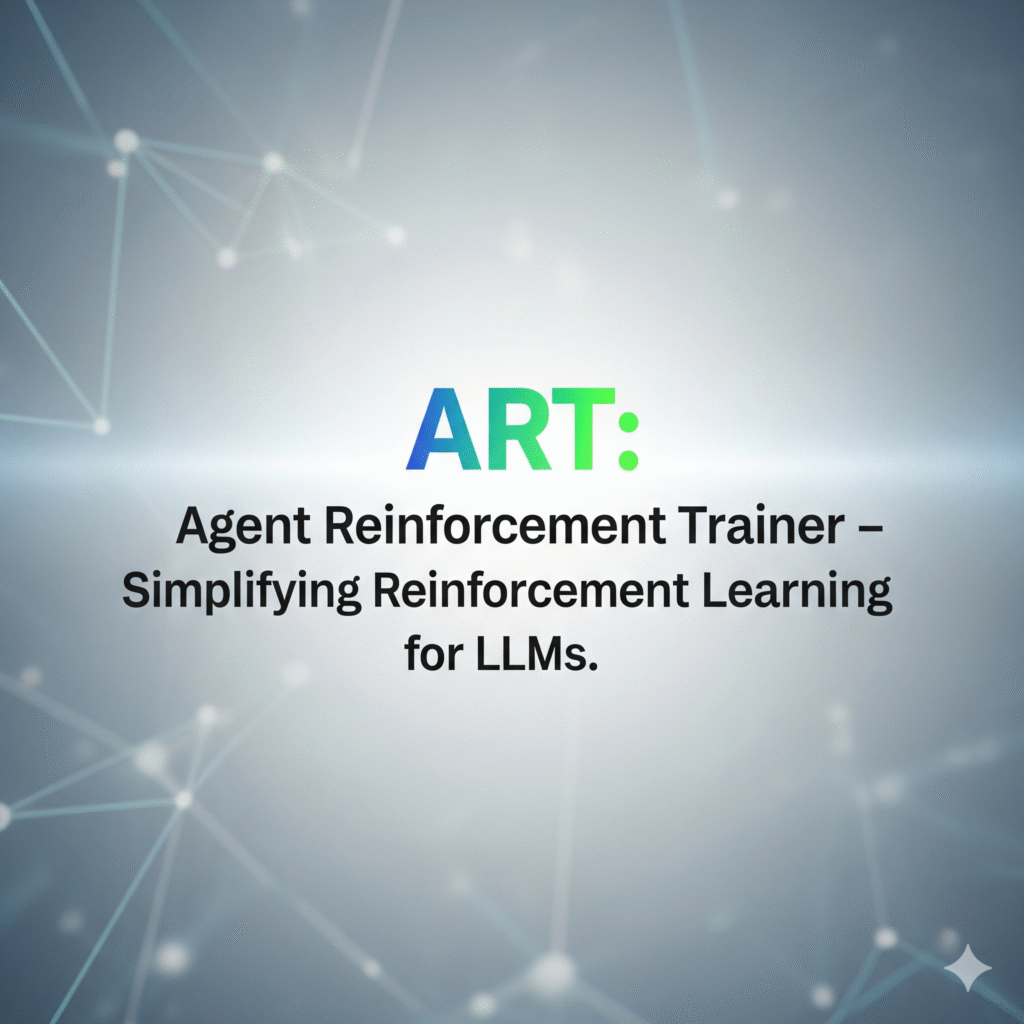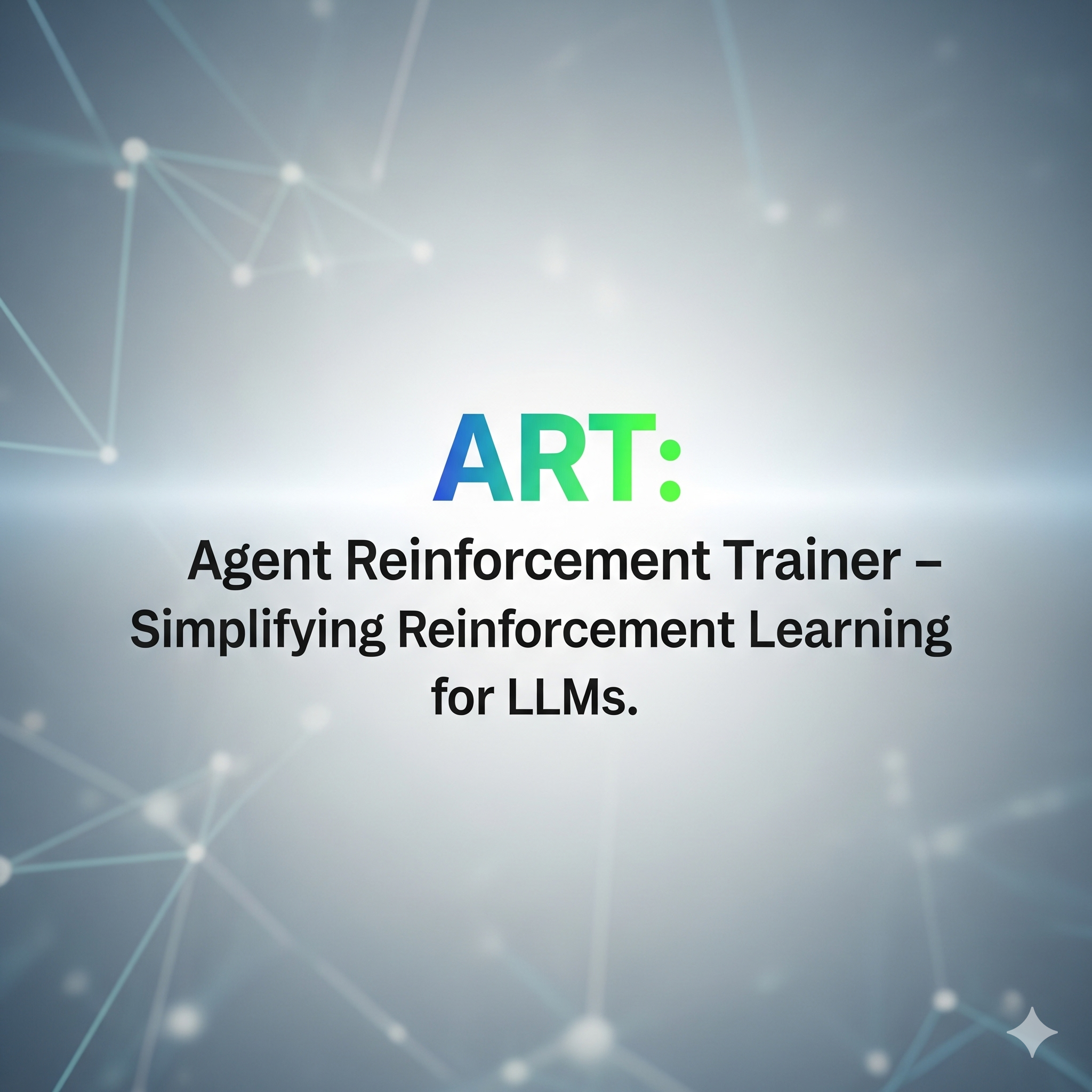In recent years, the rise of large language models (LLMs) has opened the door for more intelligent and capable agents. However, training agents to perform multi-step tasks reliably remains challenging, primarily due to the need for careful reward function engineering. Enter (ART – Agent Reinforcement Trainer) an open-source framework designed to streamline reinforcement learning (RL) for LLM-based agents.

Table of Contents
It integrates GRPO (Generalized Reinforcement Policy Optimization) with zero-shot reward evaluation using RULER, enabling rapid, scalable and effective agent training.
Key Features of Agent Reinforcement Trainer
RULER: Zero-Shot Agent Rewards
RULER (Relative Universal LLM-Elicited Rewards) eliminates manual reward engineering. Using an LLM as a judge, it automatically scores agent trajectories based on task specifications-no labeled data or handcrafted reward functions required.
Benefits:
- 2-3x faster developmen
- General-purpose: works across any task
- Strong performance: matches hand-crafted reward benchmarks
- Easy integration: drop-in replacement for reward functions
Example:
# Before: complex handcrafted reward
def complex_reward_function(trajectory):
# 50+ lines of logic
pass
# After: one line with RULER
judged_group = await ruler_score_group(group, "openai/o3")2. Modular RL Framework
It separates the client and server:
- Client: Interfaces with your codebase, executes agent workflows, and collects trajectories.
- Server: Handles training, LoRA checkpointing, and vLLM inference, abstracting the complexity of RL loops.
3. Modular RL Framework
- Works with vLLM/HuggingFace-compatible models.
- Supports ephemeral GPU environments for scalable training.
- Observability via integrations like W&B, Langfuse or OpenPipe.
How to Implement
Step 1: Install Agent Reinforcement Trainer
It can be installed via PyPI:
pip install openpipe-art
Step 2: Set Up Your Environment
Ensure you have a compatible GPU environment for server-side training. The ART server handles inference and GRPO-based training in parallel with your client.
Step 3: Start the ART Server
Run the server on a GPU-enabled machine:
art-server --model qwen-2.5-7b --gpuStep 4: Connect Your Client
Use the Python client to send messages and collect trajectories:
from openpipe_art import ArtClient
client = ArtClient(server_url="http://localhost:5000")
trajectory = client.run_agent(task="search_emails", prompt="Find unread emails from last week.")
Step 5: Assign Rewards Using RULER
Automatically judge agent behavior using RULER:
from openpipe_art import ruler_score_group
judged_group = await ruler_score_group([trajectory], model="openai/o3")
Step 6: Train Your Agent
The server trains your agent using GRPO, updating LoRA weights after each batch of trajectories. The training loop continues until your desired number of iterations is reached.
client.train(iterations=100)
Step 7: Evaluate and Iterate
After training, evaluate your agent’s performance on tasks like email search, game solving (2048, Tic Tac Toe), or multi-step reasoning workflows. Adjust configurations or task prompts as needed.
Use Cases
It has been used for:
- ART•E Agent: Qwen 2.5 14B trained to outperform OpenAI’s o3 in email search.
- MCP•RL: Mastering MCP server workflows autonomously.
- AutoRL: Zero-data agent training using RULER evaluation.
- Games: 2048, Tic Tac Toe, Codenames, and other multi-step reasoning tasks.
Why Choose Agent Reinforcement Trainer?
- Faster development cycles – no manual reward engineering.
- General-purpose – compatible with most causal language models.
- Modular and flexible – client-server separation allows easy scaling.
- Open-source and community-driven – contributions welcomed.
References and Resources
- GitHub Repository: https://github.com/openpipe/art
- Documentation: ART Docs
Conclusion
Agent Reinforcement Trainer represents a significant leap forward in simplifying reinforcement learning for large language model agents. By combining GRPO-based training with RULER’s zero-shot reward evaluation, It removes traditional barriers such as manual reward engineering and complex training pipelines. Its modular client-server architecture, seamless integrations, and support for real-world tasks make it an ideal framework for developers and researchers aiming to build reliable, multi-step AI agents.
With this, training intelligent agents is no longer a daunting taskit’s faster, more efficient and scalable. Whether you’re building agents for productivity, gaming or autonomous decision-making, It provides the tools to turn ambitious ideas into functional, high-performing AI solutions.
Related Reads
- PySpark Cheatsheet: The Ultimate Quick Reference for Big Data & Machine Learning
- Mastering the Maximum Average Subarray I Problem in Python – LeetCode 75 Explained
- Mastering the Maximum Number of Vowels in a Substring Problem in Python – LeetCode 75 Explained
- Mastering the Container With Most Water Problem in Python – LeetCode 75 Explained
- Mastering the Max Number of K-Sum Pairs Problem in Python – LeetCode 75 Explained
External Links
- GitHub Repository: https://github.com/openpipe/art
- Documentation: ART Docs


5 thoughts on “ART: Agent Reinforcement Trainer – Simplifying Reinforcement Learning for LLMs”